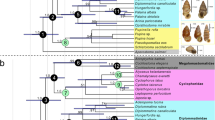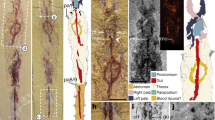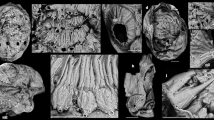Abstract
Modern chitons (Mollusca: Polyplacophora) possess a highly conserved skeleton of eight shell plates (valves) surrounded by spicules or scales, and fossil evidence suggests that the chiton skeleton has changed little since the first appearance of the class in the Late Cambrian period (about 500 million years before present, Myr bp). However, the Palaeozoic problematic taxon Multiplacophora1,2,3,4,5, in spite of having a more complex skeleton, shares several derived characters with chitons. The enigmatic status of the Multiplacophora is due in part to the fact that its members had an exoskeleton of numerous calcium carbonate valves that usually separated after death. A new articulated specimen from the Carboniferous period (about 335 Myr bp) of Indiana reveals that multiplacophorans had a dorsal protective surface composed of head and tail valves, left and right columns of overlapping valves (five on each side), and a central zone of five smaller valves, all surrounded by an annulus of large spines. Here we describe and name the articulated specimen and present evidence that multiplacophorans were chitons. Thus the highly conserved body plan of living chitons belies the broad disparity of this clade during the Palaeozoic era.
This is a preview of subscription content, access via your institution
Access options
Subscribe to this journal
Receive 51 print issues and online access
$199.00 per year
only $3.90 per issue
Buy this article
- Purchase on Springer Link
- Instant access to full article PDF
Prices may be subject to local taxes which are calculated during checkout



Similar content being viewed by others
References
Hall, J. & Clarke, J. M. Trilobites and other Crustacea of the Oriskany, Upper Helderberg, Hamilton, Portage, Chemung and Catskill Groups. Geol. Surv. NY Palaeontol. 7, 1–236 (1888)
Withers, T. H. Some Palaeozoic fossils referred to the Cirripedia. Geol. Mag. 6, 112–123 (1915)
Hoare, R. D. Lobarochiton, new generic designation for Gryphochiton? Anomolous (Rowley) (Polyplacophora). Ohio J. Sci. 76, 116–118 (1976)
Dzik, J. in Problematic Fossil Taxa (eds Hoffman, A. & Nitecki, M. H.) 116–134 (Oxford Univ. Press, New York, 1986)
Hoare, R. D. & Mapes, R. H. Relationships of the Devonian Strobilepis and related Pennsylvanian problematica. Acta Palaeontol. Pol. 40, 111–128 (1995)
Eernisse, D. J. & Reynolds, P. D. in Microscopic Anatomy of Invertebrates Vol. 5 Mollusca I (eds Harris, F. W. & Kohn, A. J.) 55–110 (Wiley Liss, New York, 1994)
Pojeta, J. Jr, Eernisse, D. J., Hoare, R. D. & Henderson, M. D. Echitonichiton dufoei: a new spiny Ordovician chiton. J. Paleontol. 77, 646–654 (2003)
Baxter, J. M. & Jones, A. M. Valve structure and growth in the chiton Lepidochitona cinereus (Polyplacophora: Ischnochitonidae). J. Mar. Biol. Assoc. UK 61, 65–78 (1981)
Hoare, R. D. & Mapes, R. H. New data on the genus Diadeloplax Hoare and Mapes, 1995. J. Paleontol. 74, 976–978 (2000)
Runnegar, B., Pojeta, J., Taylor, M. E. & Collins, D. New species of the Cambrian and Ordovician chitons Matthevia and Chelodes from Wisconsin and Queensland: evidence for the early history of polyplacophoran mollusks. J. Paleontol. 53, 1374–1394 (1979)
Sutton, M. D., Briggs, D. E. G., Siveter, David J. & Siveter, Derek J. An exceptionally preserved vermiform mollusc from the Silurian of England. Nature 410, 461–463 (2001)
Sutton, M. D., Briggs, D. E. G., Siveter, David J. & Siveter, Derek J. Computer reconstruction and analysis of the vermiform mollusc Acaenoplax hayae from the Herefordshire Lagerstätte (Silurian, England), and implications for molluscan phylogeny. Palaeontology (in the press)
Haszprunar, G. Is the Aplacophora monophyletic? A cladistic point of view. Am. Malacol. Bull. 15, 115–130 (2000)
Scheltema, A. H. & Ivanov, D. L. An aplacophoran postlarva with iterated dorsal groups of spicules and skeletal similarities to Paleozoic fossils. Invertebr. Biol. 121, 1–10 (2002)
Conway Morris, S. & Peel, J. S. Articulated halkieriids from the Lower Cambrian of north Greenland. Nature 345, 802–805 (1990)
Conway Morris, S. & Peel, J. S. Articulated halkieriids from the Lower Cambrian of North Greenland and their role in early protostome evolution. Phil. Trans. R. Soc. Lond. B 347, 305–358 (1995)
Cohen, B. L., Holmer, L. E. & Lüter, C. The brachiopod fold hypothesis: a neglected body plan hypothesis. Palaeontology 46, 59–65 (2003)
Williams, A. & Holmer, L. E. Shell structure and inferred growth functions and affinities of the sclerites of the problematic Micrina. Palaeontology 45, 845–873 (2002)
Kniprath, E. Ontogenetic plate and plate field development in two chitons, Middendorffia and Ischnochiton. Roux Arch. Dev. Biol. 189, 97–106 (1980)
Van Name, W. G. The supposed Paleozoic barnacle Protobalanus and its bearing on the origin and phylogeny of the barnacles. Am. Mus. Novit. 197, 1–8 (1925)
Aurivillius, C. W. S. Ueber einige Ober-Silurische Cirripeden aus Gotland. K. Svenska Vetensk. Akad. Handl. 18, 1–24 (1892)
Adrain, J. M. Machaeridian classification. Alcheringa 16, 15–32 (1992)
Hoare, R. D. & Mapes, R. H. Late Paleozoic problematic sclerites of hercolepadid affinities. J. Paleontol. 70, 341–347 (1996)
Van Name, W. G. A new specimen of Protobalanus, supposed Paleozoic barnacle. Am. Mus. Novit. 227, 1–6 (1926)
Swofford, D. L. PAUP*: Phylogenetic Analysis Using Parsimony (*and Other Methods) (Version 4.0b10) (Sinauer Associates, Sunderland, Massachusetts, 2002)
Acknowledgements
We are grateful to M. Graham and the staff of the US Army Corps of Engineers, Middle Wabash Area, for their cooperation in the collection and study of this fossil. We thank R. Mapes, R. Hoare, B. Haissini, E. Landing, D. Blake and C. Mah for lending specimens. K. McKeegan, G. Jarzebinski and R. Turner helped with scanning electron microscopy work and G. Gastony with the Greek. The computerized tomography scanning and image processing was carried out by M. Colbert at the X-ray CT Laboratory, University of Texas at Austin, with funding from a US National Science Foundation IGERT Fellowship to T.E.W. C. Fernandez drew the reconstruction and made the epoxy casts of modern chiton aesthete canals. G. Gastony, D. Eernisse and L. Rieseberg provided comments on the manuscript. R. Raff provided advice throughout the project.Authors' contributions All three authors made significant contributions to this article.
Author information
Authors and Affiliations
Corresponding author
Ethics declarations
Competing interests
The authors declare that they have no competing financial interests.
Supplementary information
Supplementary Movie 1
Movie of X-ray computerized tomography (CT) scan of holotype obtained at the CT Laboratory, University of Texas at Austin. (MP4 197 kb)
Supplementary Table 1
Data matrix for cladistic analysis plus explanatory notes. (XLS 25 kb)
Rights and permissions
About this article
Cite this article
Vendrasco, M., Wood, T. & Runnegar, B. Articulated Palaeozoic fossil with 17 plates greatly expands disparity of early chitons. Nature 429, 288–291 (2004). https://doi.org/10.1038/nature02548
Received:
Accepted:
Issue Date:
DOI: https://doi.org/10.1038/nature02548
This article is cited by
-
Optimized Sensory Units Integrated in the Chiton Shell
Marine Biotechnology (2022)
-
Liolophura species discrimination with geographical distribution patterns and their divergence and expansion history on the northwestern Pacific coast
Scientific Reports (2021)
-
A mitogenomic phylogeny of chitons (Mollusca: Polyplacophora)
BMC Evolutionary Biology (2020)
-
Ancestral morphology of crown-group molluscs revealed by a new Ordovician stem aculiferan
Nature (2017)
-
A Silurian armoured aplacophoran and implications for molluscan phylogeny
Nature (2012)
Comments
By submitting a comment you agree to abide by our Terms and Community Guidelines. If you find something abusive or that does not comply with our terms or guidelines please flag it as inappropriate.



